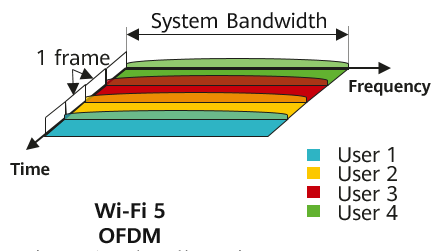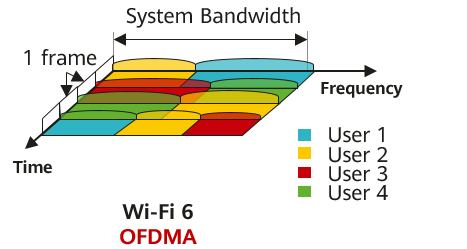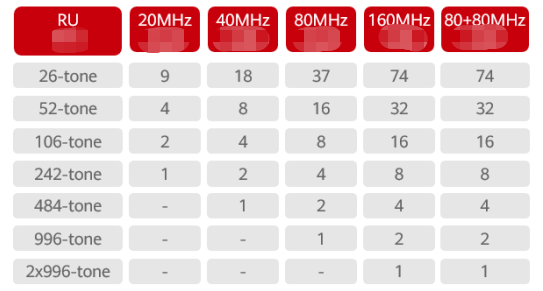release date:2022-05-27Viewers:891
What's OFDMA?
OFDMA is shorter of Orthogonal Frequency Division Multiple Access. It is the evolution of OFDM technology, which combines OFDM and FDMA technology. The transmission technology of loading transmission data on some subcarriers after subcarriers of the channel are realized by OFDM
How does OFDMA work?
The biggest difference between Wi-Fi 6 and Wi-Fi 5 is having multi-user transmission technology OFDMA, which realizes multi-user sharing of channel resources, thereby improving spectrum utilization.
Before Wi-Fi 6, data transmission was OFDM technology, where users were distinguished by different time segments. For each time segment, a user completely occupies all the subcarriers and sends a complete packet.

OFDM working mode
Wifi 6 has a more efficient data transfer mode, OFDMA (also known as MU-OFDMA because Wi-Fi 6 supports UL and DL multi-user modes). It implements multi-user multiplexing channel resources by assigning subcarriers to different users and adding multiple access to the OFDM system. It has been used by many wireless technologies, such as 3GPP LTE. In addition, the 802.11ax standard also imitates LTE, referring to the smallest sub-channel as the Resource Unit (RU), each RU contains at least 26 subcarriers, and the user is distinguished according to the RU. We divide the resources of the entire channel into small fixed-size time-frequency resource blocks RU. In this mode, the user's data is carried on each RU, so from the perspective of the total time frequency resources, it is possible to have multiple users sending at the same time on each time slice (as showed below).

OFDMA has the following advantages over OFDM:
More detailed channel resource allocation
In the case that the channel status of some nodes is not very good, the transmission power can be allocated according to the channel quality to allocate channel time-frequency resources more refined.
Provide better QoS
Because Wi-Fi 5 and the previous standards occupy the entire channel transmission data, if there is a QoS packet that needs to be sent, it must wait for the previous sender to release the entire channel, so there will be a long delay. In ofdMA mode, because a sender only occupies part of the resources of the entire channel, it can send data from multiple users at a time, which can reduce the delay of packet transmission of QoS nodes.
·
More user concurrency and higher user bandwidth
OFDMA is to divide the entire channel resource into multiple subcarriers (also known as sub-channels), and the subcarriers are divided into several groups according to different RU types, and each user can occupy one or more sets of RU to meet different bandwidth requirements. The minimum RU size in Wi-Fi 6 is 2MHz and the minimum subcarrier bandwidth is 78.125KHz, so the minimum RU type is 26 subcarrier RU. By analogy, there are 52 subcarrier RU, 106 subcarrier RU, 242 subcarrier RU, 484 subcarrier RU and 996 subcarrier RU, and the table below shows the maximum number of RU at different channel bandwidths. The greater the number of RUs, the more efficient multi-user processing and the higher the throughput when sending packet packets.

The number of RU in different bandwidths
The difference between OFDMA and MU-MIMO
Although OFDMA and MU-MIMO are both multi-user technologies that change serial transmissions into parallel transmissions, there is a big difference between the them.
MU-MIMO: Realize multiple parallel concurrency on physical space, suitable for parallel transmission of large packets (such as video, download and other applications), improve the utilization and system capacity of multi-space streams, improve the rate of single users, and also reduce latency. However, the operating state is not stable enough and is easily affected by the terminal.
OFDMA: Realizes multi-channel concurrency in the frequency domain space, which is suitable for the parallel transmission of small packets (such as web browsing, instant messaging and other applications), improves the channel utilization and transmission efficiency of single-space streams, and reduces application latency and user queuing. The operating state is stable and is not easily affected by the terminal.
Can MU-MIMO and OFDMA be used at the same time?
Of course. Because the two schemes of MU-MIMO and OFDMA do not conflict at all. OFDMA and MU-MIMO joint scheduling can allocate resources (such as web browsing, video viewing, downloading, instant messaging and other business scenarios) on a per-service basis. By designing a reasonable MU-MIMO and OFDMA scheduling algorithm, Wi-Fi 6 wireless AP can effectively reduce the conflicts caused by uplink and downstream random access in multi-user scenarios, and improve the experience of multi-user high-density access scenarios.
As an company with more than 18 years experience in the Wi-Fi/4G/5G/IOT networking, Shenzhen Kings IoT technology developed many Wi-Fi6 wireless AP to support OFDMA and MU-MIMO technology, allow more users access in high speed, less WiFi latency and provide more stable wireless signal access; Especially for the Wi-Fi6 wireless AP with Qualcomm chipset.
Jessica: sales@kingsiot.com
Whatsapp/WeChat: +86-13243803257
Tel: +86-13243803257
Add: B221, Qituo Business Building, Intersection of Baoyuan road and Gushu 2nd Road, Xixiang Town, Bao’an district, Shenzhen city, Guangdong province, China